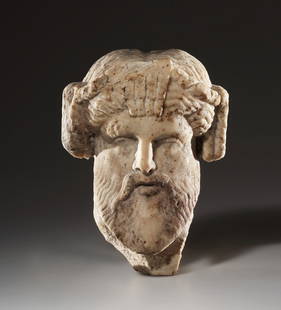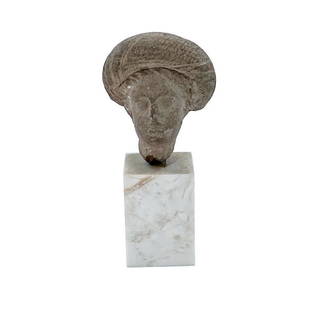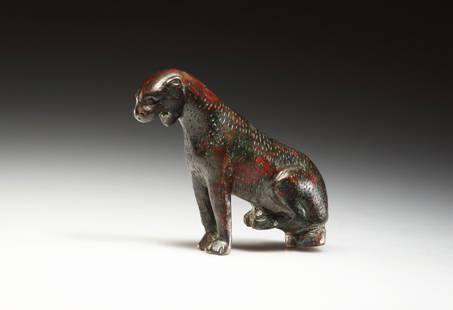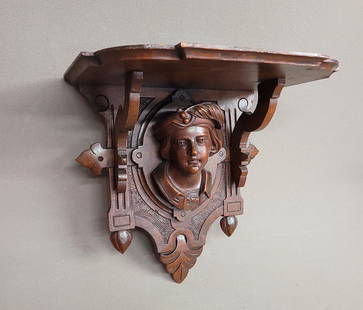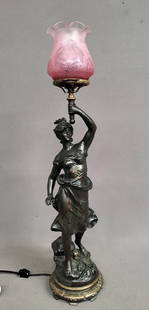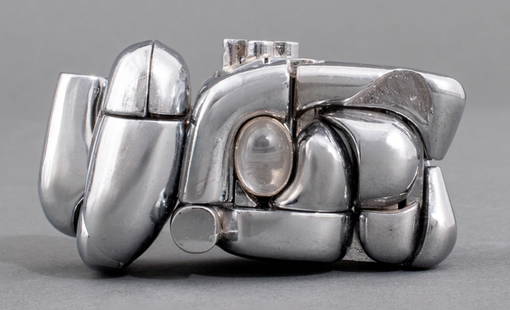
Roman Marble Goddess Magna Mater (Cybele) with Lions
Similar Sale History
View More Items in Statues & StatuettesRelated Statues & Statuettes
More Items in Ancient Greek & Roman Statues & Statuettes
View MoreRecommended Sculptures & Carvings
View More








Item Details
Description
Roman, Imperial Period, ca. 1st to 3rd century CE. A powerful portrait of an important Roman goddess, this is a half lifesize marble figure of Magna Mater (Cybele/Kybele/Rhea), sculpted from a warm, cream-colored marble with amber-colored inclusions. She is seated on a low backed throne with one hand draped over its armrest. Two lions sit obediently at her feet, as if waiting for her command. She wears a tiered chiton with a thin belt tied in a bow below her breasts. A himation sweeps across her lap and drapes over the armrest, with the folds of the fabric carefully portrayed on front and back. A large, spiral-shaped brooch is on her left shoulder. Her feet are spread apart, beautifully sculpted to include delicate sandals; one smooth leg is revealed between the folds of the fabric, which falls over the other leg to the top of the foot. Her missing hand presumbly once held one of her attributes, such as a cornucopia; it is likely that a tiered mural crown, representing the monumental architecture of a city, once graced her head. Size: 11.75" L x 17.5" W x 29" H (29.8 cm x 44.4 cm x 73.7 cm)
She sits atop an integrated plinth, with the lions' tails hanging over its sides in relief. Each lion has a full mane and muscular body. This style of portayal of the goddess - seated, flanked by lions - may be 8000 years old! The Seated Woman of Catalhoyuk, dated to ca. 6000 BCE, depicts a woman seated in the same way, with her arms resting on felines who flank her lower body as she gives birth. Although this portrayal does not explicitly reference fertility or birth, its form - and other Greek and Roman portrayals of this goddess - is similar enough to infer that they are related.
Indeed, Magna Mater is the Roman form of Cybele, a goddess with a following much more ancient than the Roman Empire. She was the Great Mother who had given birth to the other gods, all humans, and all animals. She had a large cult following in Anatolia, Phyrgia, and Greece during the 1st millennium BCE which was clearly part of an older tradition stretching back to Catalhoyuk. Her image often appears in conjunction with funerary rituals and tombs, as she was seen as a mediator of the liminal spaces between life and death.
Romans initially found the goddess strange, an artifact from the east, but after several dire events during the Second Punic War - including a meteor shower and failed harvest - they officially adopted her cult around 218-210 BCE. After consultation with the priestesses of the Sibylline oracle, the Roman Senate sought to acquire the goddess from the Kingdom of Pergamum, a Roman ally. She arrived in the form of a black meteorite from Pessinos, and was escorted by Rome's most virtuous matrons to the temple of Victoria, where she awaited construction of her own temple on the Palatine Hill. Whether via divine intervention or military strategy, the Romans eventually defeated Hannibal and conquered Carthage, cementing her power in Roman lore for centuries. During the Imperial era, Magna Mater protected Roman cities and agriculture, while those who had escorted her to the temple gained legendary status, notably the matron Claudia Quinta, whom the emperor Claudius (r. 41 to 54 CE) claimed as an ancestor. Various festivals and cults celebrated her, especially the Megalesia, which began on April 4, the anniversary of her arrival in Rome.
Provenance: private East Coast, USA collection; ex-Madame Frances Artuner collection, Belgium, collected in the 1960s
All items legal to buy/sell under U.S. Statute covering cultural patrimony Code 2600, CHAPTER 14, and are guaranteed to be as described or your money back.
A Certificate of Authenticity will accompany all winning bids.
We ship worldwide to most countries and handle all shipping in-house for your convenience.
#146685
She sits atop an integrated plinth, with the lions' tails hanging over its sides in relief. Each lion has a full mane and muscular body. This style of portayal of the goddess - seated, flanked by lions - may be 8000 years old! The Seated Woman of Catalhoyuk, dated to ca. 6000 BCE, depicts a woman seated in the same way, with her arms resting on felines who flank her lower body as she gives birth. Although this portrayal does not explicitly reference fertility or birth, its form - and other Greek and Roman portrayals of this goddess - is similar enough to infer that they are related.
Indeed, Magna Mater is the Roman form of Cybele, a goddess with a following much more ancient than the Roman Empire. She was the Great Mother who had given birth to the other gods, all humans, and all animals. She had a large cult following in Anatolia, Phyrgia, and Greece during the 1st millennium BCE which was clearly part of an older tradition stretching back to Catalhoyuk. Her image often appears in conjunction with funerary rituals and tombs, as she was seen as a mediator of the liminal spaces between life and death.
Romans initially found the goddess strange, an artifact from the east, but after several dire events during the Second Punic War - including a meteor shower and failed harvest - they officially adopted her cult around 218-210 BCE. After consultation with the priestesses of the Sibylline oracle, the Roman Senate sought to acquire the goddess from the Kingdom of Pergamum, a Roman ally. She arrived in the form of a black meteorite from Pessinos, and was escorted by Rome's most virtuous matrons to the temple of Victoria, where she awaited construction of her own temple on the Palatine Hill. Whether via divine intervention or military strategy, the Romans eventually defeated Hannibal and conquered Carthage, cementing her power in Roman lore for centuries. During the Imperial era, Magna Mater protected Roman cities and agriculture, while those who had escorted her to the temple gained legendary status, notably the matron Claudia Quinta, whom the emperor Claudius (r. 41 to 54 CE) claimed as an ancestor. Various festivals and cults celebrated her, especially the Megalesia, which began on April 4, the anniversary of her arrival in Rome.
Provenance: private East Coast, USA collection; ex-Madame Frances Artuner collection, Belgium, collected in the 1960s
All items legal to buy/sell under U.S. Statute covering cultural patrimony Code 2600, CHAPTER 14, and are guaranteed to be as described or your money back.
A Certificate of Authenticity will accompany all winning bids.
We ship worldwide to most countries and handle all shipping in-house for your convenience.
#146685
Condition
Head, one lower arm, and the front legs of the lions are partially lost. There are some small losses to the peripheries, including the back of the base, but the piece stands in a stable manner on its own. Rich patina on surface with light deposits. Wear on surface commensurate with age with some smoothing of the features, but overall excellent preservation of detail.
Buyer's Premium
- 24.5%
Roman Marble Goddess Magna Mater (Cybele) with Lions
Estimate $14,000 - $21,000
10 bidders are watching this item.
Shipping & Pickup Options
Item located in Louisville, CO, usSee Policy for Shipping
Payment

TOP




















